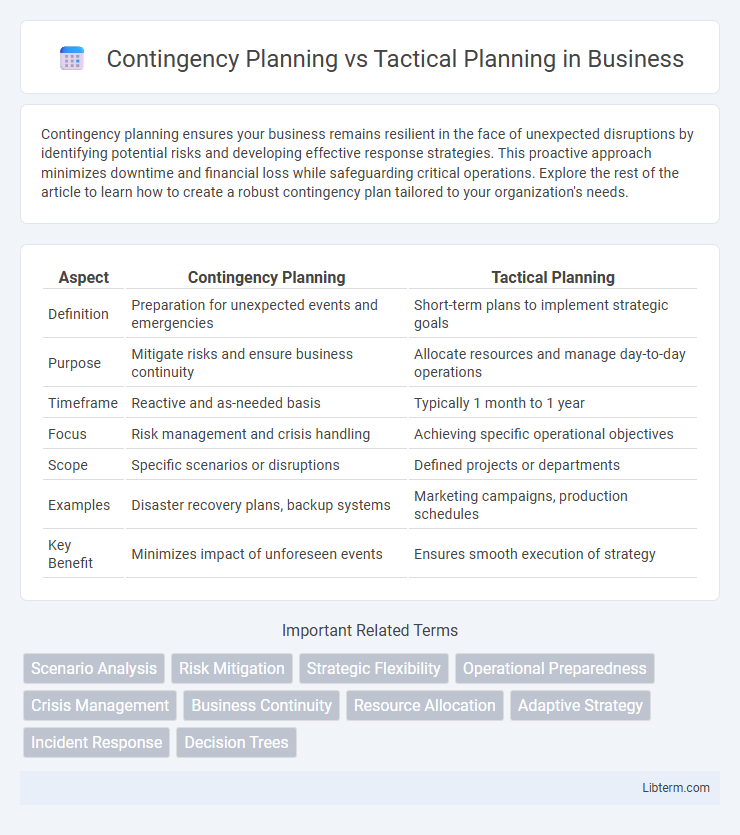Contingency planning ensures your business remains resilient in the face of unexpected disruptions by identifying potential risks and developing effective response strategies. This proactive approach minimizes downtime and financial loss while safeguarding critical operations. Explore the rest of the article to learn how to create a robust contingency plan tailored to your organization's needs.
Table of Comparison
| Aspect | Contingency Planning | Tactical Planning |
|---|---|---|
| Definition | Preparation for unexpected events and emergencies | Short-term plans to implement strategic goals |
| Purpose | Mitigate risks and ensure business continuity | Allocate resources and manage day-to-day operations |
| Timeframe | Reactive and as-needed basis | Typically 1 month to 1 year |
| Focus | Risk management and crisis handling | Achieving specific operational objectives |
| Scope | Specific scenarios or disruptions | Defined projects or departments |
| Examples | Disaster recovery plans, backup systems | Marketing campaigns, production schedules |
| Key Benefit | Minimizes impact of unforeseen events | Ensures smooth execution of strategy |
Introduction to Contingency and Tactical Planning
Contingency planning involves developing alternative strategies to address unexpected events and risks that may disrupt organizational operations, ensuring business continuity under various scenarios. Tactical planning focuses on short-term actions and resource allocation aimed at achieving specific objectives that support the broader strategic goals of a company. Both planning types are crucial for effective management, with contingency planning emphasizing risk mitigation and tactical planning driving immediate execution efficiency.
Defining Contingency Planning
Contingency planning involves developing alternative strategies that organizations implement when unexpected events disrupt primary plans, ensuring business continuity and risk management. It focuses on identifying potential threats and preparing predefined responses to minimize impact on operations. Unlike tactical planning, which outlines short-term actions to achieve specific goals, contingency planning prepares for uncertainty and emergencies by establishing flexible, adaptive measures.
Defining Tactical Planning
Tactical planning involves creating specific, short-term actions and resource allocations that align with broader strategic goals to achieve organizational objectives efficiently. It focuses on defining clear steps, timelines, and responsibilities within departments or teams, ensuring that daily operations support the strategy. Unlike contingency planning, which prepares for unforeseen events, tactical planning is proactive and detail-oriented, aiming to optimize routine performance and execution.
Key Differences Between Contingency and Tactical Planning
Contingency planning focuses on preparing alternative actions for unexpected events or emergencies, ensuring organizational resilience and risk management. Tactical planning involves developing specific, short-term actions and resource allocations to achieve strategic objectives within a defined timeframe. Key differences include contingency planning's emphasis on flexibility and adaptation, whereas tactical planning centers on implementing predefined strategies under normal conditions.
Objectives of Contingency Planning
Contingency planning aims to prepare organizations for unexpected events by identifying potential risks and developing alternative strategies to ensure business continuity. Its primary objective is to minimize disruptions, protect assets, and maintain critical operations during crises or emergencies. Unlike tactical planning, which focuses on short-term goals and resource allocation, contingency planning emphasizes risk management and adaptive responses to unforeseen challenges.
Objectives of Tactical Planning
Tactical planning focuses on translating strategic goals into specific, actionable steps within a short to medium-term timeframe, ensuring efficient resource allocation and operational execution. Its objectives include improving productivity, managing day-to-day activities, and achieving departmental targets aligned with the broader organizational strategy. Contingency planning, in contrast, prepares for unexpected events by developing alternative actions to mitigate risks and maintain business continuity.
When to Use Contingency vs. Tactical Planning
Contingency planning is essential when preparing for potential risks and uncertainties that could disrupt business operations, enabling organizations to respond swiftly to unforeseen events. Tactical planning is most effective during the implementation phase of strategic goals, focusing on short-term actions and resource allocation to achieve specific objectives. Use contingency planning to manage crises and unexpected scenarios, while tactical planning supports day-to-day decision-making and execution of planned initiatives.
Advantages and Limitations of Each Approach
Contingency planning offers the advantage of preparing organizations for unexpected events by developing alternative strategies that enhance resilience and reduce risk exposure, but its limitation lies in the difficulty of predicting every possible scenario, which can lead to over-preparation or resource strain. Tactical planning provides clear, actionable steps aligned with short-term objectives, improving operational efficiency and focus, yet it may lack flexibility to adapt quickly to sudden changes or crises. Balancing the strategic foresight of contingency planning with the detailed execution of tactical planning is essential for robust organizational decision-making.
Real-World Examples of Contingency and Tactical Planning
Contingency planning involves preparing alternative strategies for potential disruptions, such as a manufacturing company developing backup supply chain options to respond to raw material shortages during a crisis. Tactical planning, on the other hand, focuses on short-term actions to implement broader strategies, exemplified by a retail chain scheduling promotional campaigns and inventory restocking for an upcoming holiday season. Real-world examples include Toyota's contingency plans for natural disasters impacting production and Starbucks' tactical plans for store openings and marketing initiatives aligned with quarterly targets.
Best Practices for Integrating Both Planning Methods
Effective integration of contingency planning and tactical planning involves developing flexible tactical plans that incorporate predefined contingency triggers and response protocols. Organizations should establish continuous monitoring mechanisms to identify potential risks early, enabling seamless transitions between planned actions and alternative strategies when disruptions occur. Embedding cross-functional collaboration and regular scenario-based training ensures both planning methods align with organizational objectives and improve overall resilience.
Contingency Planning Infographic

 libterm.com
libterm.com